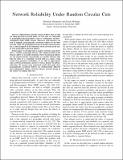Network Reliability under Random Circular Cuts
Author(s)
Neumayer, Sebastian J.; Modiano, Eytan H
Downloadseb.Neumayer.GLOBECOM2011 copy.pdf (220.8Kb)
OPEN_ACCESS_POLICY
Open Access Policy
Creative Commons Attribution-Noncommercial-Share Alike
Terms of use
Metadata
Show full item recordAbstract
Optical fiber networks consist of fibers that are laid out along physical terrestrial paths. As such, they are vulnerable to geographical physical failures, such as earthquakes and Electromagnetic Pulse (EMP) attacks. Moreover, such disasters can lead to multiple, geographically correlated, failures on the fiber network. Thus, the geographical layout of the fiber infrastructure has a critical impact on the robustness of the network in the face of such geographical physical failures. In this paper, we develop tools to analyze network connectivity after a `random' geographic disaster. The random location of the disaster allows us to model situations where the physical failures are not targeted attacks. In particular, we consider disasters that take the form of a `randomly' located disk in a plane. Using results from geometric probability, we are able to approximate some network performance metrics to such a disaster in polynomial time. We present some numerical results that make clear geographically correlated failures are fundamentally different from independent failures and then discuss network design in the context of random disk-cuts.
Date issued
2012-01Department
Massachusetts Institute of Technology. Department of Aeronautics and Astronautics; Massachusetts Institute of Technology. Department of Electrical Engineering and Computer ScienceJournal
2011 IEEE Global Telecommunications Conference - GLOBECOM 2011
Publisher
Institute of Electrical and Electronics Engineers (IEEE)
Citation
Neumayer, S., and E. "Modiano. Network Reliability under Random Circular Cuts." 2011 IEEE Global Telecommunications Conference - GLOBECOM 2011, 5-9 December 2011, Kathmandu, Nepal, IEEE, 2011, pp. 1–6.
Version: Author's final manuscript
ISBN
978-1-4244-9268-8
978-1-4244-9266-4
978-1-4244-9267-1